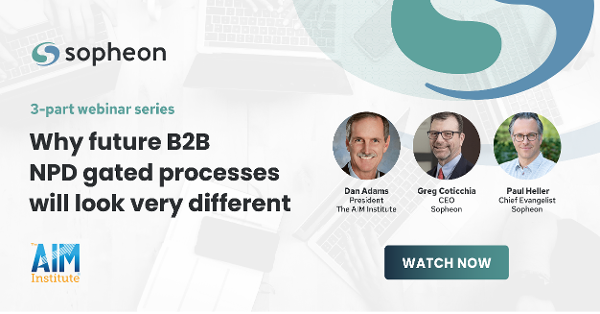Reading time: 3 minutes
Go into the [customer] interview and focus 100% on the customer outcomes. At the end of the interview, ask yourself [if] those outcomes match well with your intended solution. If they did, then you know you're on the right track.
Sopheon recently announced its partnership with The AIM Institute and later teamed up for an informative webinar that explored the importance of using Voice of the Customer and Commercial Success metrics within gated processes to ensure successful new product development (NPD) projects. Webinar presenters included AIM Institute founder and President Dan Adams, Sopheon CEO Greg Coticchia, and Sopheon Chief Evangelist Paul Heller. Dan’s NPD knowledge is second-to-none, and the following blog features highlights from his insight during this three-part webinar series.
NPD initiatives must identify problems before developing solutions
More often than not,, innovation performance falls flat because new product development projects are too focused on cool solutions the innovation team assumes will succeed, but may not necessarily address real market and customer challenges:
“[Stage-Gate® founder] Bob Cooper has done amazing research over the years, and he has found that when companies finish their front-end work and move into development, they typically have about a 25% success rate. So, let's step back a little bit and think about why this might be the case. There are probably two innovation problems we have to solve: What does the market want, and what are our solutions for this?”
“Now it turns out that the problem that most companies spend most of their time on is problem two. Research shows about 90% of a typical project spend is working on the solution. When you ask, "Well, who's idea was that? Was that yours or the customers?" the typical answer that we hear is, "Well, it was our idea, something we thought customers wanted. Then we validated it. We developed a solution."
“And then if you ask, "When did you really understand market needs?" they might say, "Well, I guess when we launched a product to see if anybody would buy it." There may be less efficient ways to understand market needs than to go through the entire new product development process, but I can't imagine what [they would be]. And yet this is the standard for many, many B2B companies today.”
Tread lightly in an idea-first scenario
When you have a great idea that may not have an identified problem to solve, it’s essential to keep the concept in the background while conducting customer research to increase the probability of new product success:
“If you've got a solution in mind, that's wonderful, but you really have three choices. Go to the customer and say, "Hey, I've got a really cool solution!” But that's where confirmation bias comes in. Or do outcomes first, [and] ignore that technology quivering on the lab bench. But that doesn't make sense. I could point to Post-it Notes from 3M or DuPont Teflon. It really was cool technology.”
“So we recommend [choice] number three. Go into the [customer] interview and focus 100% on the customer outcomes. At the end of the interview, ask yourself [if] those outcomes match well with your intended solution. If they did, then you know you're on the right track. If they did not, then you need to come up with different technology for this market. It's great to have a solution, just do not lead the witness with it.”
Differentiate between new product development outcomes and solutions
A common complaint from those in new product development is that customers can’t always articulate what they need, which requires a solution-first approach to innovation planning—an assertion Dan takes issue with:
“So, there are probably two things that are missing when they say that. The first is they're confusing outcomes with solutions. The faster horse is a solution, but that's not what we want. What we want to get to are the outcomes. Yes, you want to get there faster. Do you want to be not as cold? Do you want to not clean up the fuel source dropped on the road? All these outcomes, if we could look at those, we'd learn that they don't want a faster horse. They want something very, very different. So outcomes versus solutions is the first thing.”
“The second [consideration] is B2B versus B2C. If I'm Apple and I'm making a new iPod with 400 engineers who are also consumers already, they already have a sense for what other consumers want. But if I'm in B2B and I'm making pigment for paper, I don't know much about that paper process. So B2B companies have a lot to learn, and if they seek the outcomes, they will learn a lot from their customers who are knowledgeable, interested, objective and foresighted.”
Watch this three-part best practice series on infusing customer insights into your innovation process to learn more.







